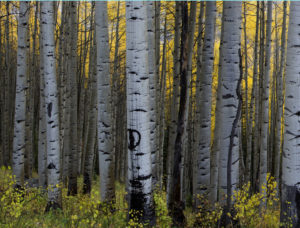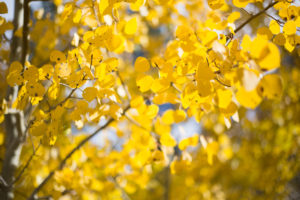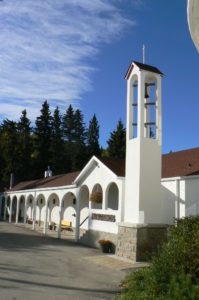Mount St. Francis is a retreat centre in the foothills of the Rocky Mountains where all are welcome in the name of Christ. The Franciscan Friars of Western Canada, inspired by the vision and example of St. Francis and St. Clare of Assisi, have served in this spiritual centre of peace, healing, and prayer since its foundation in 1949. This year’s silent retreat theme is “Creation: Loving Gift of God”. In this excerpt from a retreat presentation, the centre’s Director, Susan Campbell, gives us hope-filled life lessons from the backwoods.
Look deep inside nature and then you will understand everything better.”
-Albert Einstein
This year at Mount St. Francis we are using creation as a doorway to contemplating the mystery of our existence and our journey. The Franciscan theologian St. Bonaventure calls our attention to three important lessons from nature.
The first is that we come forth from God bearing the divine image; our very DNA is found in Him.
The second is that everything in creation is an example and illustration of the ‘one God’ mystery in space and time.
And finally, everything returns to the Source from which it came.
Using these three teachings, let’s consider what we might learn from a rather ordinary example from nature: an aspen grove. The aspen tree is often called a trembling aspen or quaking aspen because of the way the leaves tremble with even the slightest breeze.
Aspens propagate not only through seeds but also through cloning, creating colonies. New shoots come out of the root system to form new trunks that are the same as the parent plant. The largest colony is called Pando (Latin for “I spread”) and it is found in Fishlake National Forest in Utah. It is said that the parent tree lived 80,000 years ago and ever since that time the colony has grown and propagated until today. It stretches over 43 hectares (106 acres) and weighs 6600 tons. There are over 40,000 trunks or stems on this one tree!
 It is fascinating to think that while the trunks, which we see as individual trees, can emerge, mature and die, the root system itself endures and spreads. It will even survive fire. Fire can be a good thing, removing deadwood or competing tree species, giving new shoots the opportunity to grow. For 80,000 years this process has been faithfully repeating itself. This forest was already ancient before the first peoples started to populate North America. So here we see the first lesson from the aspen – they share the same DNA.
It is fascinating to think that while the trunks, which we see as individual trees, can emerge, mature and die, the root system itself endures and spreads. It will even survive fire. Fire can be a good thing, removing deadwood or competing tree species, giving new shoots the opportunity to grow. For 80,000 years this process has been faithfully repeating itself. This forest was already ancient before the first peoples started to populate North America. So here we see the first lesson from the aspen – they share the same DNA.
Just as aspens emerge from a parent or ancient source, we can go back in our own family history and see that we share some of the same characteristics as our forebears – even if we have not known them personally. Here, I’m not referring only to the physical or psychological characteristics we have inherited from our ancestors, but the spiritual characteristics that we inherit from our divine source.
Within a Christian framework, the God of love is the origin of all creation. So we are the gift of a loving Creator who desires to express something of His goodness, truth, beauty, presence and action in our world. This is not a “clockmaker” God who creates only to have the created world run independently with its own laws. It is a God who desires intimacy and closeness with us. It is in our DNA to reflect the oneness of creation – and the love at the heart of it all.
This leads to the second lesson: everything is an example or illustration of that deeper reality of love. When we think of love we often have an image of something soft, malleable, romantic and cozy. Yet, we know that love is also fierce, forthright, challenging, and truth-telling. Love stands with and for the other even in the face of disappointment and hurt. Even unto death. I am mindful of a caveat here. Love doesn’t mean having to stay in an abusive relationship. No one is required to stay in a situation that is death-dealing: where one is threatened physically, emotionally, mentally or spiritually. The most loving thing that one can do, often times, is to remove oneself from a relationship such as this.
Saying that, we see examples all around us of what people will do out of love. The young family that gives birth to and raises a physically or mentally challenged child. The family that accepts the sexual orientation of their son or daughter, even at the price of losing friends. The spouse who forgives an act of infidelity from his or her partner.
Yet, it is also true that love is not always evident in our actions. So where does the shadow side come from? Where does the ugliness, harm, deception and division come from? They come from our choices, our warped sense of self or sense of the other. In her book Turning to the Other, Margaret Wheatley says “You can’t hate someone whose story you know.” I have also come to realize that you can’t ignore someone’s presence or plight, when your heart is open to love.
When we don’t recognize and acknowledge our common humanity, we become protectionist, defensive, judgmental, and perhaps even violent. We turn in on ourselves rather than turn toward the other.
If we return to the aspen tree, we can learn a few more lessons from its common life. The fact that it lives in community means that it is attentive to the needs of the whole. Spreading over a vast area, it shares whatever moisture or nutrients that are available in one area with another that is depleted or dry. We are called to do the same. It could be sending money to those who have lost everything in a fire, or sharing hay with a neighboring rancher experiencing a drought. It could be teaching someone a new skill. The examples are endless. It doesn’t take much effort to recall someone in our lives who made a difference to us when we needed it most.
 Our roots contain wisdom that we need to tap into again and again. We are guided by the elders; those who are wise. At Mt. St. Francis, we have monthly Twelve Step twilight retreats, and the participants come from far and wide, all walks of life, young and old. The young people, especially those in recovery programs, are looking up to the elders in the group. Feeling lost and adrift, those new to the program see something of the struggle that these elders have experienced, and also sense the hope that life can be different for them, too.
Our roots contain wisdom that we need to tap into again and again. We are guided by the elders; those who are wise. At Mt. St. Francis, we have monthly Twelve Step twilight retreats, and the participants come from far and wide, all walks of life, young and old. The young people, especially those in recovery programs, are looking up to the elders in the group. Feeling lost and adrift, those new to the program see something of the struggle that these elders have experienced, and also sense the hope that life can be different for them, too.
Far above the roots, the leaves also have their place in the community. They dissipate the energy and reduce the stress on the tree. Being able to express ourselves through celebration, sorrow, and hurt is also necessary. Just as the leaves change colours in the different seasons, so we too have seasons in our lives that call forth different colours.
As winds blow, the moving leaves also all ow the sun to shine on the lower leaves, improving the health of the whole tree. We are called to move aside sometimes, and let the light fall on another.
ow the sun to shine on the lower leaves, improving the health of the whole tree. We are called to move aside sometimes, and let the light fall on another.
The mystery of our interconnectedness with love, with the Divine, often entails suffering, a ‘letting go’. Suffering is not something foreign to human experience, but is integral to it. It allows us to mature as people. And it is often rooted in our desire that reality be different than it is.
I don’t believe God sends us hardship or disaster to teach us a lesson. Rather, I believe God breaks open hardship and transforms it into something life-giving. We’ve all met people who live with disabilities or who have come through a personal trial, and emerge with greater compassion, trust, empathy, vitality or peace. They had to let go of something in order to come to that place. What it calls for on our part is to work through all the layers of the experience that causes us suffering: expectations of what we had wanted, self-centeredness, blame…whatever they are.
Here we can see the importance of fire in the life of the aspen. Fire is useful and sometimes even necessary to clear out disease, overgrowth, and invasive species. For me, this is the third lesson: returning to the source and being transformed. Sometimes there is a dying to what was, in order to create something new. One example of this for me is the resurgence of the First Nations peoples reclaiming their own culture and community life. The failed attempts at assimilation are opening into a time of new opportunity. I am a member of an organization called “Returning to Spirit” that works to heal the damaging legacy of the Indian Residential Schools in Canada. The work we do comes from a place of partnership between aboriginal and non-aboriginal peoples. I have gained a new appreciation and respect for First Nations peoples and what they have experienced.
Nature has a cycle of life and death that perpetuates the species. Life emerges from death. We see this in the simplest seed. It dies to what it was, in order for something new to unfold. The husk, the hard kernel, has to soften and break open in order for that to happen.
It’s the same with the hardness that we keep around our hearts for protection. Through the power of love, humility and hope, it is broken open and transformed into something far greater.
For information, photos and videos of Mt. St. Francis Retreat Centre, and to find out about upcoming events, visit www.mountstfrancis.ca








